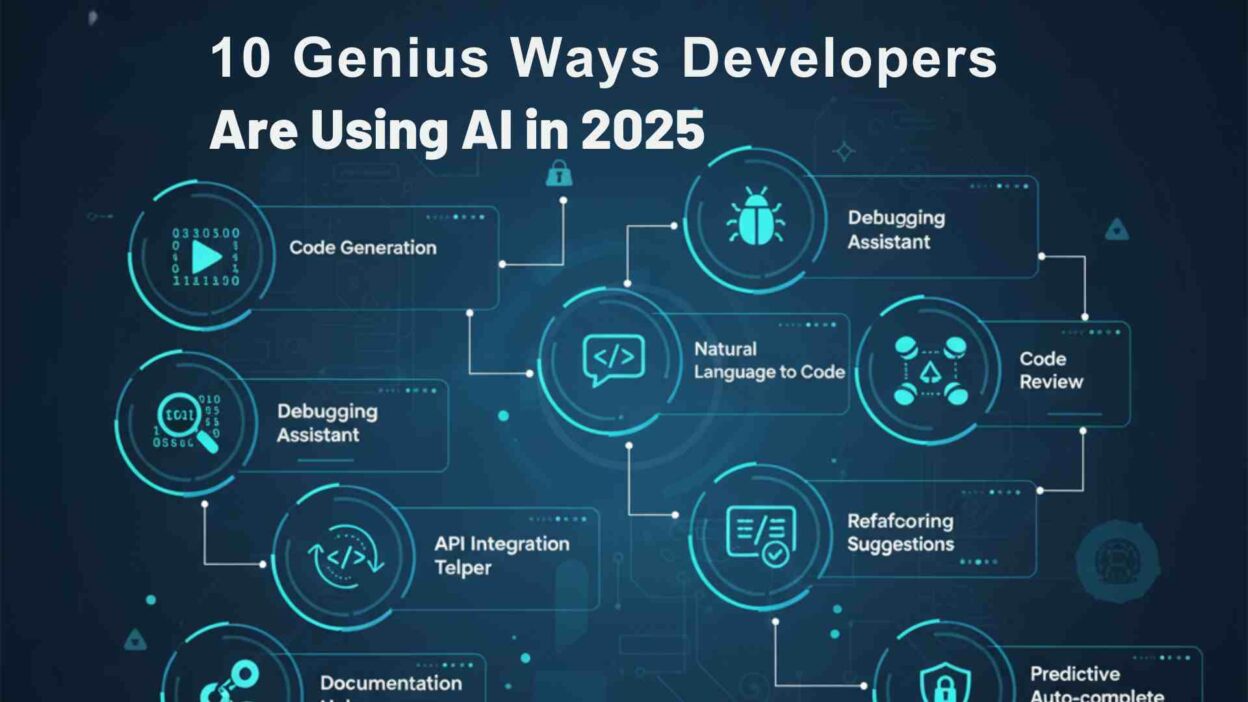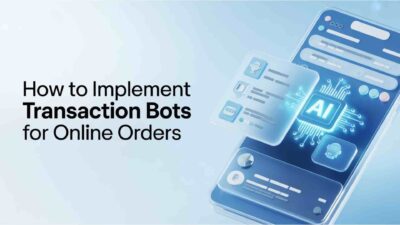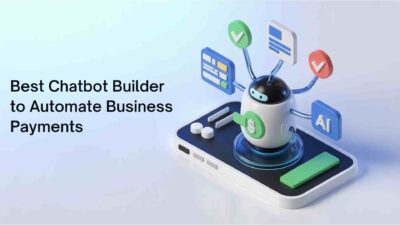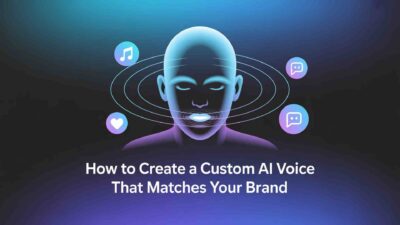Introduction
TL;DR Software development transforms dramatically in 2025. Artificial intelligence reshapes every aspect of coding. Developers worldwide adopt AI tools daily.
Table of Contents
The question is no longer whether to use AI. The focus shifts to how developers use AI effectively. Innovation happens at unprecedented speed.
Traditional development methods feel outdated already. AI capabilities expand rapidly each month. New possibilities emerge constantly.
This comprehensive guide explores ten genius applications. Real developers share their AI strategies. Practical examples demonstrate transformative results.
Productivity gains exceed initial expectations significantly. Quality improvements happen simultaneously with speed increases. The development landscape changes fundamentally.
Early adopters gain competitive advantages immediately. Teams embracing AI outperform traditional approaches. The gap widens with each passing month.
Understanding how developers use AI becomes essential. These ten strategies represent current best practices. Implementation guidance helps you start today.
1. AI-Powered Code Generation
Writing Code Through Conversation
Developers describe desired functionality in plain language. AI translates intentions into working code instantly. Programming becomes more like a conversation.
Complex algorithms emerge from simple descriptions. Mathematical operations appear without manual coding. Business logic implements itself automatically.
Natural language processing understands context deeply. AI grasps what developers truly need. Suggestions match intentions accurately.
Code generation happens across multiple languages. Python, JavaScript, Java, and more work seamlessly. Language barriers disappear completely.
Real-World Implementation
Developers create entire functions through prompts. Backend APIs generate from endpoint descriptions. Database queries appear from natural requirements.
Frontend components emerge from design descriptions. UI elements create themselves automatically. Responsive layouts appear without manual CSS.
How developers use AI for generation varies by project. Startups build MVPs in days instead of weeks. Enterprise teams accelerate feature development dramatically.
Boilerplate code becomes completely obsolete. Standard patterns generate instantly. Developers focus only on unique logic.
Best Practices
Start with clear, specific descriptions. Ambiguous prompts produce unclear results. Precision improves output quality dramatically.
Review the generated code carefully initially. Understanding output builds trust gradually. Verification ensures correctness consistently.
Iterate on prompts to refine results. AI learns from feedback quickly. Output quality improves with interaction.
Combine AI generation with human expertise. Review architectural decisions thoughtfully. Strategic thinking remains human domain.
2. Intelligent Code Review and Analysis
Automated Quality Assurance
AI reviews every pull request instantly. Code quality issues surface before human review. Teams avoid lengthy back-and-forth cycles.
Pattern recognition identifies common mistakes. Security vulnerabilities get flagged immediately. Best practice violations appear highlighted.
Performance issues surface during development. Inefficient algorithms get spotted automatically. Optimization happens before deployment.
How developers use AI for reviews saves hours daily. Manual inspection focuses on logic only. Syntax and style check automatically.
Security Vulnerability Detection
AI scans for known exploit patterns. Security libraries stay updated automatically. Protection happens proactively.
Injection attack vulnerabilities surface immediately. SQL, XSS, and CSRF issues get prevented. Applications stay secure by default.
Dependency vulnerabilities trigger instant alerts. Outdated packages get identified automatically. Updates happen before breaches occur.
Compliance violations appear during development. Regulatory requirements get enforced automatically. Audit preparation becomes effortless.
Implementation Strategies
Integrate AI into existing workflows. Pull request automation works seamlessly. Developers receive instant feedback.
Customize rules for organizational standards. AI learns company-specific patterns. Reviews match team preferences.
Track metrics to measure improvement. Code quality trends become visible. Progress demonstrates value clearly.
Combine automated and manual reviews. Human judgment catches contextual issues. Collaboration produces the best results.
3. Smart Bug Detection and Debugging
Predictive Bug Finding
AI predicts where bugs likely hide. Code complexity analysis reveals risks. Testing focuses on vulnerable areas.
Machine learning identifies problematic patterns. Historical bug data informs predictions. Prevention happens before issues occur.
Runtime behavior analysis detects anomalies. Unusual patterns trigger investigations. Problems surface before users notice.
How developers use AI for debugging accelerates fixes. Root cause analysis happens automatically. Resolution time drops dramatically.
Automated Root Cause Analysis
Stack traces get analyzed intelligently. AI identifies actual problem sources. Red herrings get filtered automatically.
Error logs receive smart parsing. Relevant information surfaces immediately. Noise disappears from the analysis.
Dependencies get mapped automatically. Cascading failures become clear instantly. System-wide issues reveal themselves.
Historically, similar issues appear automatically. Solutions to past problems surface. Knowledge sharing happens automatically.
Debugging Best Practices
Enable comprehensive logging everywhere. AI needs data for analysis. Information improves diagnostic accuracy.
Integrate AI into monitoring systems. Real-time detection prevents escalation. Issues are resolved before impacting users.
Document fixes for AI learning. Systems improve with every resolution. Organizational knowledge compounds.
Combine AI insights with human investigation. Context matters for complex issues. Collaboration produces the fastest resolution.
4. Intelligent Test Automation
Automatic Test Generation
AI creates test cases from requirements. Comprehensive coverage happens automatically. Edge cases get identified without manual thought.
User stories convert to test scenarios. Business logic drives test creation. Validation happens at the specification level.
Regression test suites expand automatically. Code changes trigger relevant test generation. Coverage maintains itself continuously.
How developers use AI for testing eliminates tedious work. Test writing becomes nearly automatic. Focus shifts to test strategy.
Self-Healing Test Scripts
UI changes break traditional tests constantly. AI-powered tests adapt automatically. Maintenance burden disappears completely.
Element locators update themselves intelligently. Tests find components despite changes. Stability improves dramatically.
Test data is generated automatically. Realistic scenarios appear without manual creation. Data management becomes effortless.
Flaky tests get identified and fixed. AI determines root causes automatically. Test reliability reaches new levels.
Advanced Testing Strategies
Visual regression testing happens automatically. Pixel-perfect comparison catches UI issues. Design consistency maintains itself.
Performance testing simulates realistic loads. AI generates diverse user patterns. Bottlenecks surface before production.
Security testing runs continuously. Penetration testing happens automatically. Vulnerabilities get discovered proactively.
Accessibility testing validates compliance. WCAG requirements check automatically. Inclusive design happens by default.
5. Automated Documentation Creation
Code Documentation
Comments generate automatically from code. Complex logic gets explained clearly. Documentation stays current effortlessly.
Function descriptions appear automatically. Parameters and return values document themselves. API contracts stay accurate always.
Architecture explanations emerge from analysis. System structure becomes clear visually. Onboarding accelerates dramatically.
How developers use AI for documentation saves countless hours. Manual writing becomes unnecessary. Quality remains consistently high.
API Documentation
Endpoints document themselves automatically. Request and response formats appear clearly. Integration becomes straightforward.
Code examples generate for multiple languages. Developers see usage in preferred syntax. Adoption accelerates significantly.
Change logs compile automatically. API evolution stays documented. Breaking changes get communicated clearly.
Interactive documentation updates in real-time. Changes reflect immediately. Documentation never falls behind.
User Guide Generation
Feature descriptions write themselves automatically. User-facing documentation appears from code. Technical writing workload decreases.
Screenshots and diagrams generate automatically. Visual aids appear without manual creation. Comprehension improves significantly.
Tutorials create themselves from features. Step-by-step guides emerge automatically. User adoption accelerates.
Translations happen automatically. Multiple languages appear instantly. Global reach expands effortlessly.
6. Intelligent Code Refactoring
Technical Debt Identification
AI scans codebases for improvement opportunities. Code smells get identified automatically. Priorities become clear immediately.
Complexity metrics highlight problem areas. Refactoring candidates surface automatically. Effort estimates appear for planning.
Duplicate code gets detected across projects. Consolidation opportunities emerge clearly. Maintainability improves systematically.
How developers use AI for refactoring transforms maintenance. Legacy code modernizes gradually. Quality improves continuously.
Automated Code Transformation
Refactoring happens while preserving behavior. Tests validate correctness automatically. Confidence remains high throughout.
Design pattern application happens automatically. Code structure improves intelligently. Readability increases dramatically.
Performance optimizations appear contextually. Slow code gets improved automatically. Applications run faster consistently.
Migration to new frameworks accelerates. AI handles boilerplate transformations. Upgrades complete faster.
Implementation Approach
Start with low-risk refactoring projects. Build confidence through small wins. Scale gradually to critical systems.
Maintain comprehensive test coverage. Safety net enables bold improvements. Regression risk decreases dramatically.
Review AI suggestions carefully initially. Understanding builds trust gradually. Automation expands with confidence.
Track metrics to demonstrate value. Code quality trends prove effectiveness. Investment justification becomes clear.
7. AI-Assisted Learning and Skill Development
Personalized Learning Paths
AI assesses current skill levels automatically. Knowledge gaps get identified precisely. Learning plans customize themselves.
Resources appear based on learning style. Visual, textual, or interactive content surfaces. Comprehension maximizes for each person.
Progress tracking happens automatically. Achievements get recognized immediately. Motivation stays high consistently.
How developers use AI for learning accelerates growth. Skill development happens faster. Career advancement accelerates.
Real-Time Code Assistance
AI explains unfamiliar code instantly. Complex concepts become clear immediately. Learning happens during work.
Best practices appear contextually. Suggestions teach while assisting. Knowledge compounds continuously.
Anti-patterns get flagged with explanations. Understanding why matters builds expertise. Learning reinforces itself.
Alternative approaches appear automatically. Multiple solutions expand thinking. Problem-solving skills improve.
Knowledge Sharing
Team expertise captures automatically. Tribal knowledge becomes accessible. Onboarding accelerates dramatically.
Questions get answered instantly. AI retrieves relevant information. Productivity stays high.
Code examples surface from organization. Internal patterns become discoverable. Consistency improves naturally.
Mentorship scales through AI assistance. Junior developers access expertise constantly. Team capability rises.
8. Intelligent Project Management
Automated Task Estimation
AI predicts completion times accurately. Historical data informs estimates. Planning becomes more reliable.
Complexity analysis guides effort allocation. Difficult tasks get identified early. Resource assignment optimizes automatically.
Risk assessment happens continuously. Potential delays surface proactively. Mitigation starts immediately.
How developers use AI for planning improves delivery. Commitments become more reliable. Stakeholder trust increases.
Resource Optimization
Team member assignments optimize automatically. Skills match tasks perfectly. Productivity maximizes across teams.
Workload balancing happens intelligently. Burnout prevention becomes proactive. Team health improves.
Dependencies get mapped automatically. Critical paths become clear. Bottlenecks get addressed early.
Sprint planning improves through analytics. Velocity predictions become accurate. Commitment sizing optimizes.
Progress Tracking
Status updates generate automatically. Manual reporting becomes unnecessary. Transparency increases effortlessly.
Blockers get identified instantly. Help arrives before delays happen. Momentum maintains itself.
Burndown charts update in real-time. Progress stays visible continuously. Adjustments happen quickly.
Retrospectives gain data-driven insights. Improvement opportunities surface clearly. Team performance increases.
9. AI-Powered Code Search and Navigation
Intelligent Code Discovery
Natural language queries find relevant code. Developers describe what they seek. Exact locations appear instantly.
Semantic search understands intent deeply. Related code surfaces automatically. Context becomes clear immediately.
Cross-repository search happens seamlessly. Knowledge spans entire organization. Silos disappear completely.
How developers use AI for navigation saves hours weekly. Context switching costs decrease. Productivity improves measurably.
Pattern Recognition
Similar code patterns get identified automatically. Reuse opportunities appear clearly. Duplication decreases naturally.
Usage examples surface for any function. Real implementations demonstrate best practices. Learning happens through examples.
Impact analysis shows code dependencies. Change effects become clear before modifications. Risk assessment happens automatically.
Dead code gets identified automatically. Cleanup opportunities surface clearly. Maintenance burden decreases.
Implementation Benefits
Onboarding accelerates dramatically. New team members navigate confidently. Productivity starts earlier.
Code reviews improve through context. Reviewers understand changes faster. Quality feedback happens quicker.
Refactoring becomes safer. Dependencies appear clearly. Unintended consequences prevent themselves.
Knowledge transfer happens organically. Code becomes self-documenting. Understanding spreads naturally.
10. Intelligent Infrastructure Management
Automated DevOps
Infrastructure provisions itself automatically. Configuration happens from requirements. Manual setup disappears completely.
Deployments orchestrate intelligently. Rollouts happen during optimal windows. Risk minimizes automatically.
Scaling responds to demand instantly. Resources adjust automatically. Cost optimization happens continuously.
How developers use AI for infrastructure reduces operations work. Development teams stay focused. Velocity increases dramatically.
Performance Optimization
Resource usage optimizes continuously. AI right-sizes infrastructure automatically. Costs decrease while performance improves.
Bottlenecks get identified proactively. Optimization happens before issues occur. User experience stays excellent.
Capacity planning becomes predictive. Growth patterns inform scaling. Resources provision ahead of need.
Cost anomalies trigger instant alerts. Budget overruns prevent themselves. Financial control improves.
Monitoring and Alerting
Anomaly detection happens automatically. Unusual patterns trigger investigations. Issues surface before becoming critical.
Alert fatigue disappears through intelligence. Noise gets filtered automatically. Focus stays on real problems.
Incident response accelerates dramatically. Root cause analysis happens automatically. Resolution time drops significantly.
Predictive maintenance prevents outages. Systems self-heal automatically. Reliability reaches new levels.
Read More: Can AI Make Opinion Polls More Accurate Than Ever?
Conclusion

Developers using AI gain extraordinary advantages. Productivity multiplies beyond traditional limits. Quality improves simultaneously with speed.
These ten strategies represent current best practices. Real developers apply these techniques daily. Results transform software development completely.
How developers use AI will evolve continuously. New capabilities emerge monthly. Innovation accelerates exponentially.
Starting requires minimal investment. Many tools offer free tiers. Learning curves remain manageable.
Early adoption creates competitive advantages. Teams embracing AI outperform peers consistently. Market leadership follows technological adoption.
Resistance stems from unfamiliarity usually. Experience builds confidence rapidly. Success converts skeptics quickly.
The development profession transforms fundamentally. AI becomes essential rather than optional. Adaptation defines career success.
These strategies work across all domains. Web, mobile, embedded, and enterprise benefit equally. Universal application makes adoption valuable.
Developer satisfaction increases with AI tools. Tedious work disappears from routines. Creative challenges become the primary focus.
Future developments promise even greater capabilities. Autonomous systems emerge gradually. Human roles evolve toward strategy.
Your journey can start immediately. Choose one strategy to explore. Learn through practical application.
How developers use AI defines modern software engineering. Mastery becomes a professional necessity. Competitive positioning depends on adoption.





